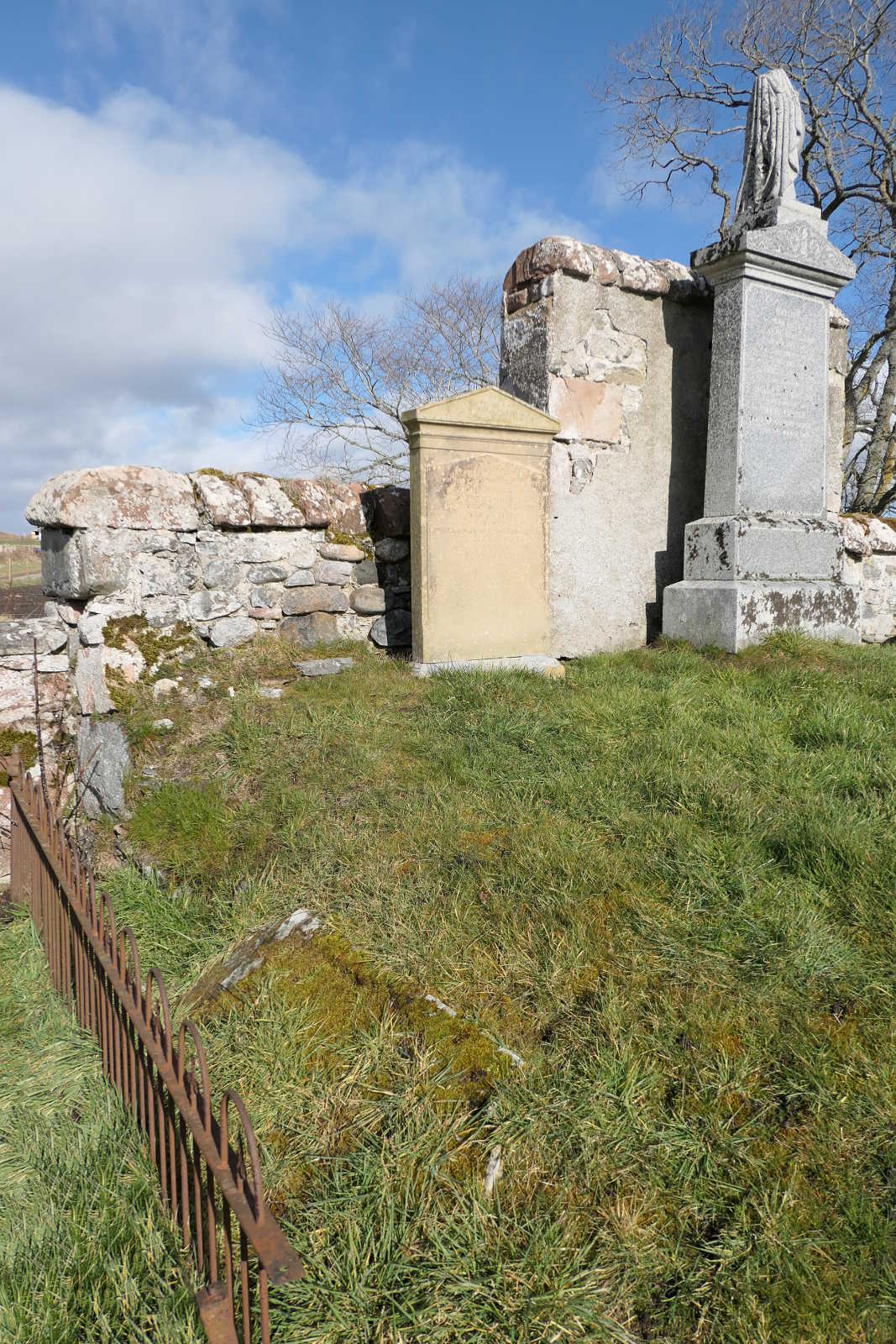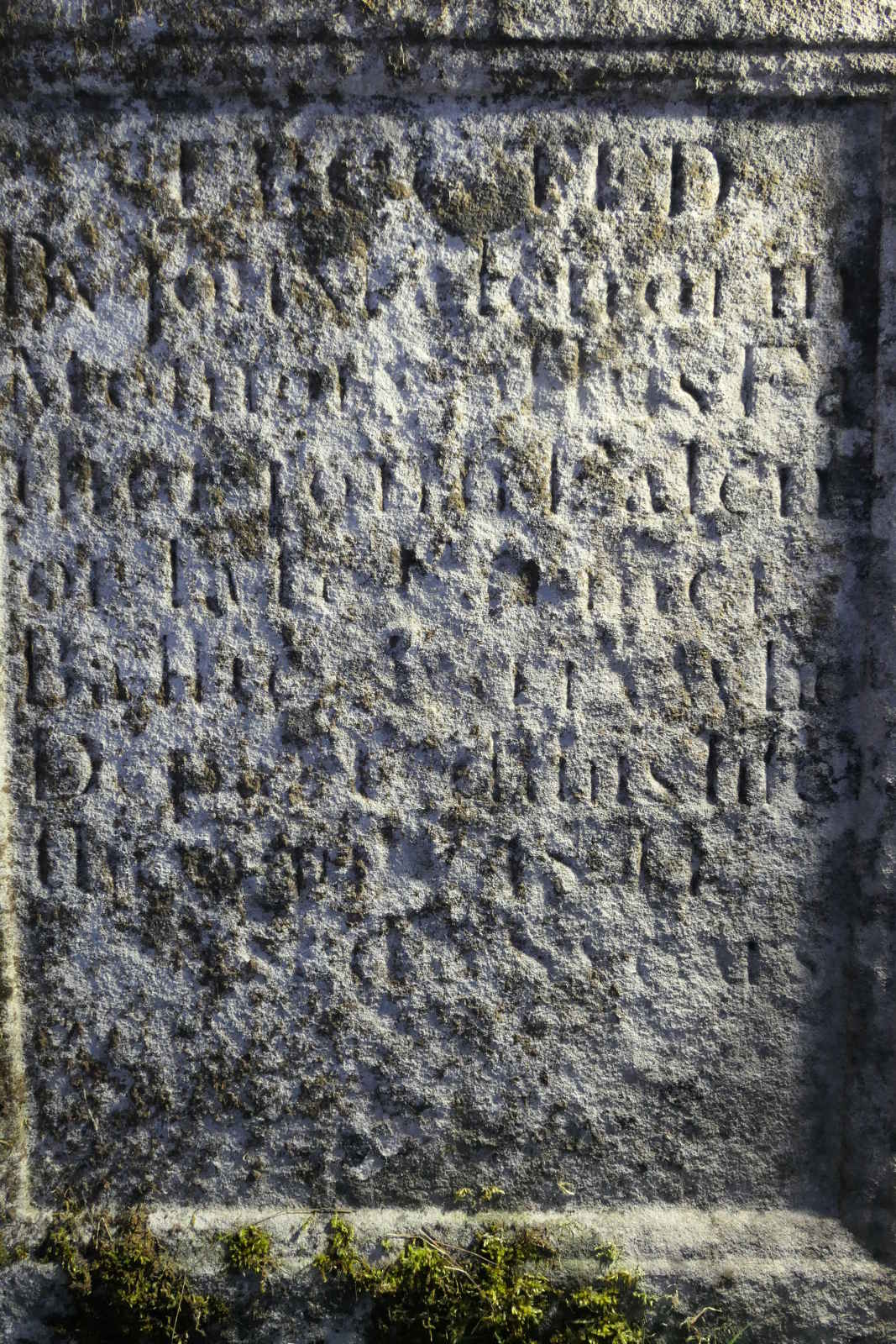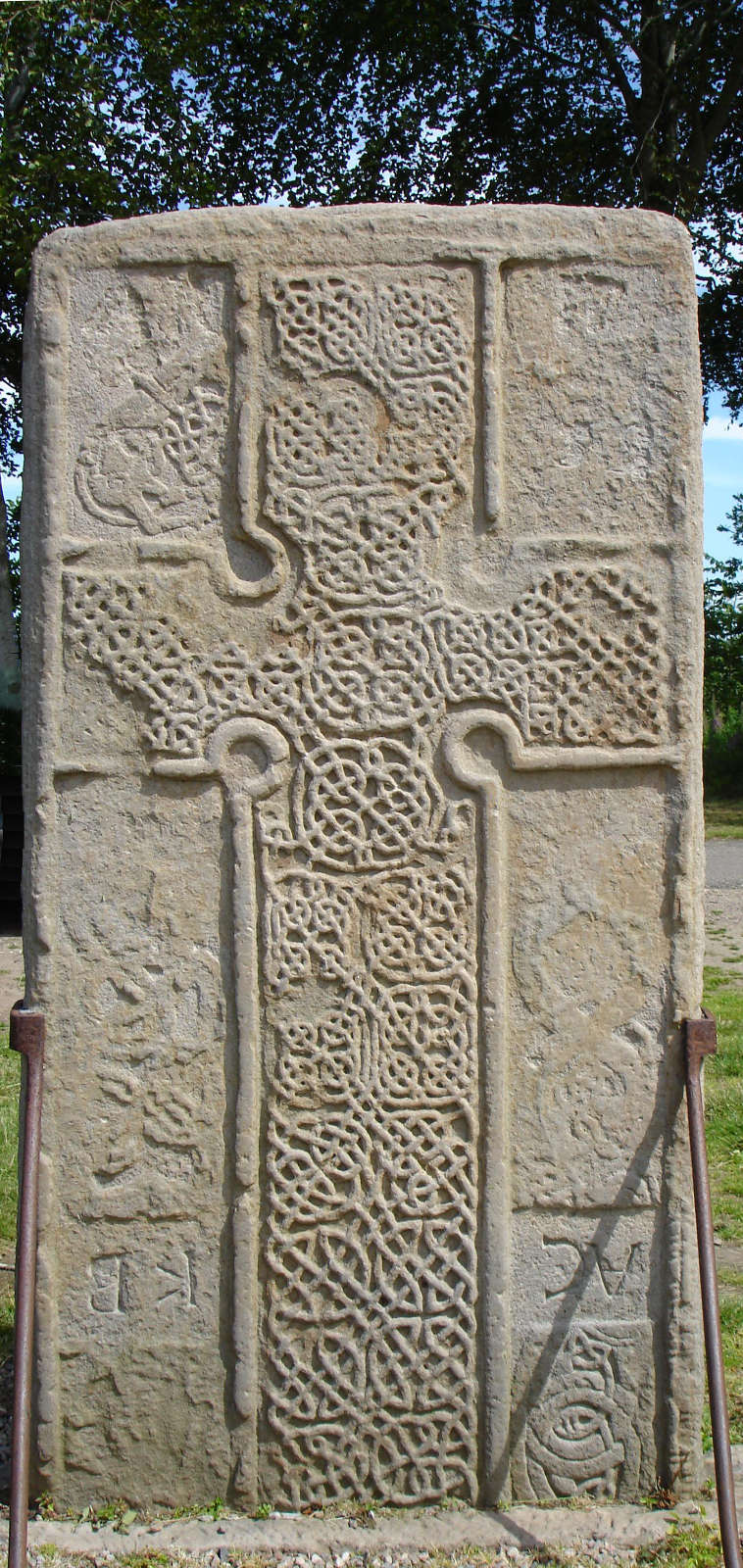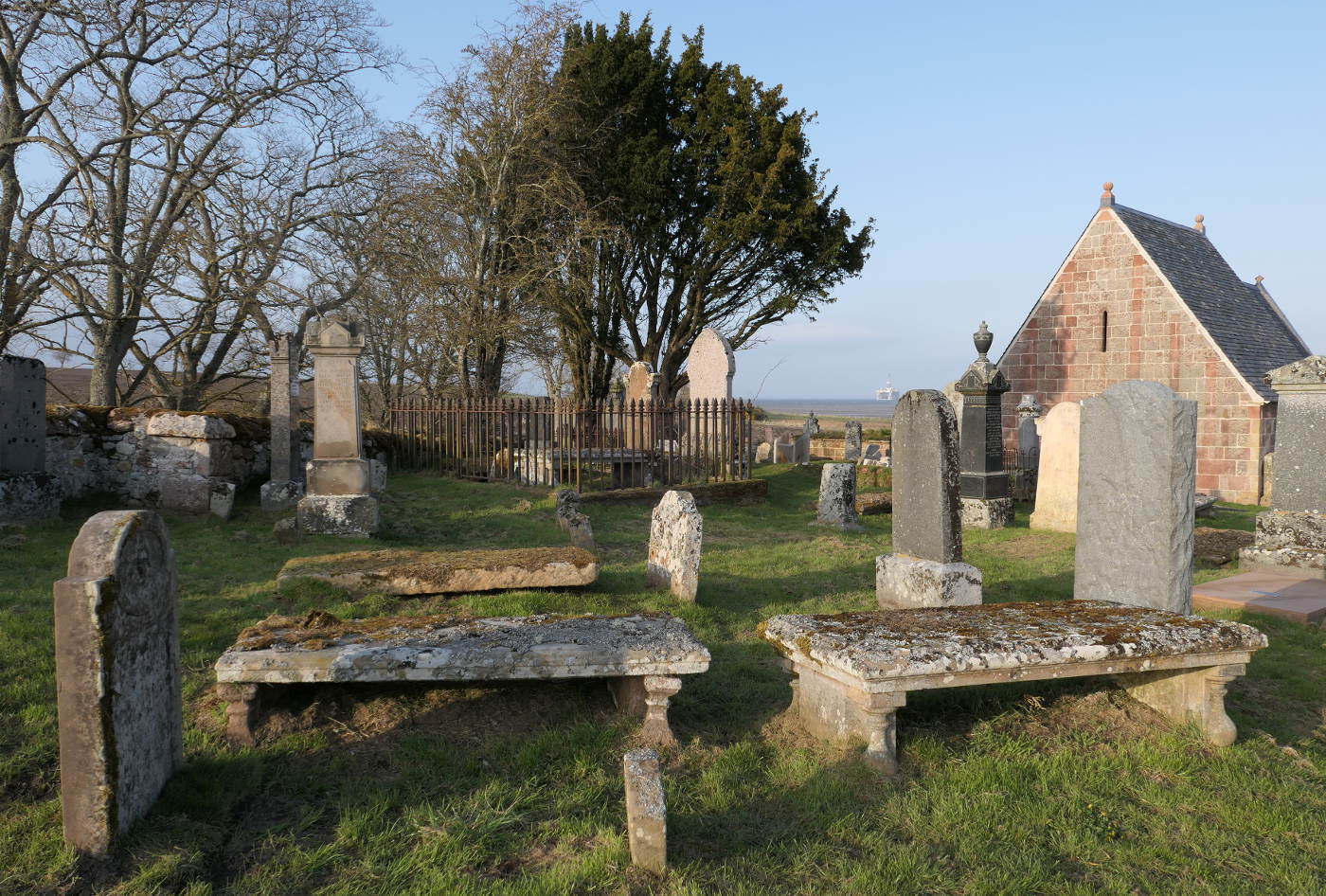The Story behind the Stone – the families, estates and stories of Kirkmichael, Cullicudden, the Black Isle and beyond
John Falconer of Ballicherry – and Crowhall, Moray: a rescued headstone
text: Dr Jim Mackay photography: as given
This is a stone abandoned decades ago. Visitors to Kirkmichael here in the Black Isle would see this headstone spread-eagled half-way down the bank from the old graveyard to the new and regard it as a symptom of a site that had passed the point of no return.
We tried to record the inscription back in 1997 but got very little from it. Clearly it was of relatively recent origin, but for some reason or other the carved face would not give up the information chiselled into it.
With the buildings at Kirkmichael restored in 2017, we could turn our attention to abandoned stones. A party of us probed the area close to the bank down which the stone had been cast, until Davine successfully located a sandstone base just a metre or so from the headstone, but well below the surface. We excavated it, and found a most unusual situation. Headstones have a protruding lip which lodges into a matching slot in the base. Here that slot had been filled with chunks of sandstone and the slot slathered over with lime plaster. Why? The lip of the abandoned headstone was slightly larger than the slot in the base. Had there been some mistake in the construction of headstone and base?
Whatever, the small lip on the headstone had clearly been unable to support the stone itself, and when it had failed the headstone had simply been slid down the bank out of the way.

The abandoned headstone, embedded in the bank. Photo: Jim Mackay

The Kirkmichael volunteers having located the base. Photo: Jim Mackay

The undersized and filled socket, and the nearby headstone. Photo: Jim Mackay
If the structure of the headstone was deficient, the carving of the inscription was even poorer. But in 2018 we would not take no for an answer.
We tried the usual tricks, such as tring to read it at different times of day when the light was low; or trying to pick out individual words and building on that; or splashing water on it and examining it obliquely. Eventually most of the text was picked out, but we still could not get the dates, ages and surname. Rather fundamental!

The disproportionately small lip. Photo: Davine Sutherland

The delicate, unfolding flowerbud. Photo: Davine Sutherland

Trying to read the stone using daylight. Photo: Andrew Dowsett
Kirsty and I came out with our LED floodlight, the Kirkmichael Lampie, one evening just after sunset and took several dozen pictures with the floodlight held at oblique angles close to the plane of the stone, all the way around. Goodness knows what folk passing in their cars would have thought with the bright light moving around in the graveyard. Slowly the final elements of the inscription started to come together. Part of the problem had been that the surname was unusual for this area of the Black Isle, and had been phonetically spelled. This is how it reads:
ERECTED / By JOHN Falcnor in / Memory of his Fa / ther JOHN Falcn- / or late farmer of / Balliecherry who / Departed this life / the 3 July 1841 / Aged 58 years

One of many photographs taken using the Kirkmichael Lampie, and the unsuspected surname of Falcnor appears. Photo: Jim Mackay

As recent as 1841 but impossible to decipher under normal conditions! For all its deficiencies, the stone itself has a pleasing shape and is headed with a most attractive flower bud.
On 7 April 2018, we securely re-erected the stone, just in front of its support, the first time it had been upright for at least 30 years.

The Kirkmichael volunteers carry the Falconer headstone back to its original location. Photo: Christine Cameron

Ensuring the headstone is set vertically. Photo: Christine Cameron

The Falconer headstone now safely back in position. Photo: Jim Mackay
And who was this family called "Falcnor"? Well, the spelling was in keeping with the poor design of the edifice. The 1841 Census, taken on 6 June 1841, so just a few weeks before John died, gives the correct rendition of the family name:
Balicherrie
John Falconer 60 Farmer
Isabel Thomson 50
Alexr Falconer 30
Ann Falconer 32
The inscription had been difficult enough to decipher, but the Falconer family proved even more challenging to untangle. On-line genealogies for the family contain howling errors. I shall provide detailed information here simply to put the record straight for others researching the family.
But all those websites had a gap into which John Falconer and his wife Isabel Thomson had disappeared – and of course they had disappeared into Ballicherry in our parish of Resolis. Like the inscription, the story did eventually come together.
John Falconer in the parish of Dyke married Isabel Thomson in the parish of Duffus on 9 January 1797. Both parishes are in Moray. Researching Dyke on the web comes with its own challenges, but I did discover that John farmed for a long time at the unusually-named Crowhall in Dyke. He and Isabel had at least 10 children while there, including twin boys, Alexander and John, in 1805. It was quite a substantial tenancy, and I note that in the horse tax returns of 1797, the year of his marriage, John Falconer of Crowhall had six horses, three of which were liable in duty. Witnesses at the baptisms of their children included various Falconers at the Mill of Brodie, who will be other members of the family. Isabel's mother was a Falconer, too.

The Parish of Dyke and Moy is famous for Macbeth's heath and its castles. This is Brodie Castle, now an NTS property. Rodney's Stone was moved from the church at Dyke to Brodie Castle grounds. Photo: Creative Commons

Three Kirkmichael Trustees in front of the magnificent stairs into Darnaway Castle. Photo: An obliging passer-by

Rodney's Stone. Photo: Creative Commons
Well, at some point John and Isabel took the leap to cross the firth to take up the tenancy of Ballicherry in the Black Isle. We know exactly when this occurred, as John, when taking up his voting rights, had to make a case for why he was entitled to vote. The extension of voting rights had just been promoted, initially by Stewart Mackenzie of Seaforth. This is the record, lodged on 16 August 1832 with Resolis schoolmaster George Murray:
SCHEDULE F. Part First CLAIM OF ENROLMENT, Shire of Cromarty
I John Falconer residing at Ballcherry hereby claim to be enrolled as a Voter in the County of Cromarty, as Tenant or Occupier of the Farm or Lands of Ballcherry part of the Estate of Poyntzfield in the Parish of Risolis and County of Cromarty; held by me in Lease from Major George Gunn Munro Esq of Poyntzfield which Lease is dated 25th day of June 1829 endures for 21 years and the rent is one hundred and forty pounds Sterling
So John had taken on Ballicherry (an excellent arable farm) in 1829 on a 21 year lease. I note in passing that John voted, not surprisingly, in line with his landlord, Major George Gun Munro of Poyntzfield, in 1832 (for Munro of Novar as opposed to Seaforth), in 1835 (for Mackenzie of Applecross as opposed to Seaforth), and in 1837 (for Mackenzie of Muirton as opposed to Applecross). There were only a couple of dozen voters in the entire parish, so these votes counted! Every vote that was even slightly shaky was challenged vigorously, but John Falconer's seems to have been solid.

The ploughed field vertically above Kirkmichael here and the adjacent bright green field lie on either side of the farmstead and farmhouse of Ballicherry. It was a short distance for John Falconer between home and final resting-place. Photo: Andrew Dowsett
Whilst he had taken on a 21 year lease in 1829, in fact Ballicherry had been advertised for some time on a lease of 19 years, at an annual rent of £150, so that there clearly had been some negotiation. This is the relevant portion of the advertisement in the Inverness Journal of 3 November 1826:
To Let, On Leases of 19 Years, The Following Farms, on Estate of POYNTZFIELD:–
BALLICHERRY, containing 100 Acres Arable, and a few Pasture. Rent, L150. Entry at Martinmas 1826.
…
For further particulars, apply to Major Munro, by Cromarty; (if by letter, post paid.)
November 1, 1826.
Gun Munro had previously had to publish a rather strange announcement, in the Inverness Courier of 15 February of that year:

An annual rent of £140 was a substantial sum, and John Falconer must have come into Ballicherry with considerable resources. He did have some financial difficulties in 1832, though, as I note that a Forres solicitor, Adam Davidson, was pursuing him for some small debts in the Cromarty Sheriff Court. But then, it may have been a matter of principle which caused the dispute.
Given that Falconer had at least 10 children whilst at Dyke, how many came over with him to Ballicherry? We can see in the 1841 Census, just before his death, that only two were living in Ballicherry with him, and there were no other Falconers residing in Resolis at the time. The two recorded were Alexander and Ann, the latter of whom doesn't feature in the baptism list.
Alexander Falconer (1805-1875)
Son Alexander was not a healthy young man. In the Militia List for Resolis made out on August 1828 he appears at "Balcherrie" but is excused from having to participate in the selection process: "Alexander Falconer tacksman's son <30 sickly Ex". Having said that, it was astonishing what diseases and infirmities manifested themselves when the militia lists came round! But given he retired quite early from being a farmer, I suspect he did suffer ill health.
We pick him up in the 1851 census on the farm of Easter Craigend, in the parish of Dallas, back in Moray, sharing his new home with his mother and twin brother John (abbreviations expanded and servants not included):
Isabella Falconer head widow 69 house manager Elginshire New Spynie
Alexander Falconer son unmarried 33 farmer of 34 acres & employs 3 servts Elginshire Dyke
John Falconer son unmarried 33 mason Elginshire Dyke
Alexander retired early. In 1861 he was a lodger in Elgin at number 272 on the High Street, unmarried, aged 54, and a "retired farmer", born in Dyke. Similarly, in 1871 he was living as the "head" in part of number 23 South College Street, unmarried, aged 60, and a "retired farmer", born in Dyke. And it was on South College Street that he died, of apoplexy, at the reasonable age of what I calculate was 70 years (though he is given as 69 on the death certificate):
Alexander Falconer retired farmer (single) 18 May 1875 at 15 South College Street, Elgin aged 69 parents John Falconer farmer (d) Isabella Falconer ms Thomson (d) informant James Falconer nephew 87 High Street Elgin.
That nephew of his, James Falconer of 87 High Street, Elgin, was the son of Elgin master baker, James Falconer, and somehow when reporting his own father's death to the registrar, made a mistake over the name of his grandfather:
James Falconer baker (master) (married to Ann Bowie) 1 Aug 1877 at 87 High Street, Elgin, aged 77 parents James Falconer farmer (d) Isabella Falconer ms Thomson (d) informant James Falconer son (present).
That error by registrar or son must have caused much difficulty to descendants researching the family over the years!
John Falconer (1805-1858)
Returning to that 1851 census return for the farm of Easter Craigend, in the parish of Dallas, we saw that John was working as a mason.
This is a most interesting finding and raises an intriguing question, given that the headstone at Kirkmichael was erected by John. Might he have carved the stone, deficiencies and all, himself?
The parish of Dallas contains quite a number of quarries, and he may well have been working in one of these. He suffered from tuberculosis which must have made the tough job of being a mason even harder. He died just a couple of years after his mother, at Easter Craigend.
Falconer John mason (single) died 7 Oct 1858 Easter Craigend Dallas aged 44 years, parents John Falconer farmer (d) Isabella Falconer ms Thomson (d), cause of death: consumption, 2 years; buried parish churchyard of Duffus as certified by William Mitchell undertaker informant Alexr Falconer brother (present)
Duffus comes up a lot in connection with the family! I haven't pursued the other children, though I see that that several feature on various family trees on the web. As ever, don't rely on that sort of information without checking the primary material yourself. For example, their mother Isabel Falconer is reported on several websites as having died in 1870 at the age of 98, in Elgin, with parents John Thomson and Isabella Macintosh, which is, every single bit of it, plain wrong. Let's look at the real facts.
Isabel Falconer ms Thomson (1777-1856)
Following the death of her husband John at Ballicherry in 1841, Isabel stayed on at Ballicherry for at least a couple of years. She had been a communicant since 1829. The first communicants' roll she appears on was dated 3 July 1829, so she had become a communicant almost immediately upon her arrival in the parish. She appeared regularly as Mrs Falconer Ballicherry thereafter, until becoming, on the roll of 6 September 1841, "Falconer Widow Balcherry". She appeared with that description on the roll of 11 July 1842, but a complication then arises. The year of 1843 was the year of the Disruption. She never appears again in any of the records of the Church of Scotland, but it would be useful to inspect the records of the Free Church of Scotland, as she may have followed minister Donald Sage and most of the congregation into the new Free Church.
She had moved with her twin sons Alexander and John to the farm at Easter Craigend in the parish of Dallas by the time of the 1851 census, when her age was given as 69.

The area of Craigend, parish of Dallas. Photo: Anne Burgess, Creative Commons Licence

The farmland just outside Dallas, with Tor Castle behind. Photo: Des Calhoun, Creative Commons Licence

The Kirkyard at Duffus (StPeter's Kirk). Photo: not known
And it was at Easter Craigend that she died, of "old age", on New Year's day 1856. Son John was the informant.
Falconer Isabella (widow) 1 Jan 1856 Easter Craigend Dallas aged 75 years parents James Thomson farmer (d) Isabella Thomson ms Falconer (d) buried Parish Church-yard, Duffus, as certified by William Mitchell undertaker, informant John Falconer son (present)
The work of the Moray Burial Ground Research Group in recording stones at Duffus contains many references to Falconers, but Isabel does not appear – yet. Perhaps a headstone is lying there at the old kirkyard at Duffus, perhaps even carved by son John, just as her husband's lay in Kirkmichael for so long.
With Isabel's death record located, we can identify her true roots – unlike the fantasy parents that have been grafted onto her on the web:
New Spynie 1777
Isabel lawful daughter to James Thomson and Isabel Falconer in Findracie was born October 22d and Baptd October 29th. Witnesses John Walker in Spynie William Falconer and Mrs Murray both in Duffus.
Again the Duffus connection. As I say, I do hope she appears on a gravestone in Duffus kirkyard. There would have been no space on the headstone in Kirkmichael, anyway. Another design fault! But at least that headstone is now securely re-erected where it was originally intended to stand.

The Falconer Headstone restored after many years. Photo: Jim Mackay